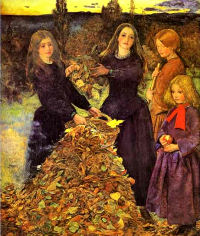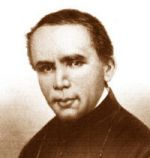October 2020 - Overview for the Month
The month of October is dedicated to the Holy Rosary. The Memorial of Our Lady of the Rosary is celebrated on October 7. October falls during the liturgical season known as Ordinary Time, which is represented by the liturgical color green. This symbol of hope is the color of the sprouting seed and arouses in the faithful the hope of reaping the eternal harvest of heaven, especially the hope of a glorious resurrection. It is used in the offices and Masses of Ordinary Time.
The Laity's Mission in the Church: We pray that by the virtue of baptism, the laity, especially women, may participate more in areas of responsibility in the Church. (See also http://www.popesprayerusa.net/)
The feasts on the General Roman Calendar celebrated during the month of October are:
1. Thérèse of the Child Jesus, Memorial
2. Holy Guardian Angels, Memorial
4. TWENTY-SEVENTH SUNDAY IN ORDINARY TIME, Sunday
5. Bl. Francis Xavier Seelos (USA); St. Faustina Kowalska, Opt. Mem.
6. Bruno; Bl. Marie Rose Durocher (USA and CAN), Opt. Mem.
7. Our Lady of the Rosary, Memorial
11. TWENTY-EIGHTH SUNDAY IN ORDINARY TIME, Sunday
14. Callistus I, Opt. Mem.
15. Teresa of Jesus, Memorial
16. Hedwig; Margaret Mary Alacoque, Opt. Mem.
17. Ignatius of Antioch, Memorial
18. TWENTY-NINTH SUNDAY IN ORDINARY TIME, Sunday
19. John de Brebeuf, Isaac Jogues and Companions (USA), Memorial
20. Paul of the Cross, Opt. Mem.
22. John Paul II, Opt. Mem.
23. John of Capistrano, Opt. Mem.
24. Anthony Mary Claret, Opt. Mem.
25. THIRTIETH SUNDAY IN ORDINARY TIME, Sunday
28. Simon & Jude, Apostles, Feast
All the Gospels for the Sundays in October 2020 are taken from St. Matthew and are from Year A, Cycle 2.
October
4th - 27th Sunday in Ordinary Time |
This Gospel recounts the parable of the landowner and the vineyard. |
October
11th - 28th Sunday in Ordinary Time |
This Gospel recounts the parable of the wedding banquet. |
October 18th - 29th Sunday in Ordinary Time |
Jesus says to "Render to Caesar what is Caesar's". |
October 25th - 30th Sunday in Ordinary Time |
In this Gospel Jesus gives us the greatest commandment. |
 During
October, as in all of Ordinary Time (formerly known as Time After
Pentecost), the Liturgy does not focus on one particular mystery
of Christ, but views the mystery of Christ in all its aspects. We
follow the life of Christ through the Gospels, and focus on the
teachings and parables of Jesus and what it means for each of us to be a
follower of Christ. During Ordinary Time we can concentrate more
During
October, as in all of Ordinary Time (formerly known as Time After
Pentecost), the Liturgy does not focus on one particular mystery
of Christ, but views the mystery of Christ in all its aspects. We
follow the life of Christ through the Gospels, and focus on the
teachings and parables of Jesus and what it means for each of us to be a
follower of Christ. During Ordinary Time we can concentrate more
This month the main liturgical feasts are St. Thérèse (October 1), Guardian Angels (October 2), St. Faustina (October 5), St. Bruno (October 6), Our Lady of the Rosary (October 7), St. Callistus I (October 14), St. Teresa of Jesus (October 15), St. Hedwig and St. Margaret Mary (October 16), St. Ignatius of Antioch (October 17), St. Isaac Jogues, St. John de Brébeuf and Companions (October 19), St. Paul of the Cross (October 20), St. John Paul II (October 22), St. Anthony Mary Claret (October 24) and Sts. Simon and Jude (October 28) .
The feasts of St. Francis of Assisi (October 4), St. John XXIII (October 11) and St. Luke (October 18) are superseded by the Sunday liturgy.
 October usually is an enjoyable time of the year in the United States. The
autumn season manifests itself with wonderful fall foliage in many
parts of the country. The temperatures are cooler, inviting people
outdoors for nature walks, apple or pumpkin picking. School routines
are more established and football season is in full swing. The celebrations
of the Church for the month of October are also wonderful and unique.
The feasts of some of the most popular saints of the universal Church
are celebrated during this month: St. Therese the Little Flower
(France), St. Francis of Assisi (Italy) and St. Teresa of Avila
(Spain). These saints come from different countries, and in honoring
these saints we can include cultural dishes or activities from each
country to make the feastday even more special. Read more about
the lives of these saints. Perhaps the family can pick one virtue
that each saint practiced well and try to implement it.
October usually is an enjoyable time of the year in the United States. The
autumn season manifests itself with wonderful fall foliage in many
parts of the country. The temperatures are cooler, inviting people
outdoors for nature walks, apple or pumpkin picking. School routines
are more established and football season is in full swing. The celebrations
of the Church for the month of October are also wonderful and unique.
The feasts of some of the most popular saints of the universal Church
are celebrated during this month: St. Therese the Little Flower
(France), St. Francis of Assisi (Italy) and St. Teresa of Avila
(Spain). These saints come from different countries, and in honoring
these saints we can include cultural dishes or activities from each
country to make the feastday even more special. Read more about
the lives of these saints. Perhaps the family can pick one virtue
that each saint practiced well and try to implement it.
The feasts in October also include two of the most popular, time-honored devotions of Catholics, the devotion to the Holy Rosary (October 7) and the Guardian Angels (October 2). In October 2002 our Holy Father John Paul II wrote the Apostolic Letter Rosarium Virginis Mariae (the Rosary of the Virgin Mary)." This letter introduced five new mysteries, called the Luminous or Mysteries of Light, which are (1) Jesus' Baptism in the Jordan, (2) Jesus' self-manifestation at the wedding of Cana, (3) Proclamation of the Kingdom of God, with the call to conversion, (4) the Transfiguration, and (5) the Institution of the Eucharist. Try to make a more concerted effort to pray the Rosary together as a family during the month of October, read the Apostolic Letter to understand the beauty of this devotion more deeply, and pray the new Luminous mysteries. October 16 is known as "Pope Day" on which we celebrate the gift of the papacy and our current pope.
Every person has a guardian angel assigned to them, and October 2 the Church celebrates the role of these Guardian Angels. We should show devout gratitude to God for placing these angels at our service. Having a guardian should give us confidence during all of life's difficulties. Every Catholic should know the Angele Dei (Angel of God) prayer and pray it often. The Directory on Popular Piety suggests that families pray it at morning and evening prayers or after the Angelus.

All Hallows' Eve or Halloween heralds the month of November with emphasis on the Communion of Saints, especially the Church Suffering (the Poor Souls in Purgatory) and the second coming of Christ or parousia. This last day of October on the secular calendar is second only to Christmas in commercial preparations. The secular festivities center on ghouls, witches and devils, but the Christian counterpart focus on the communion of saints. As Christians living a "Catholic Culture", we should try to explore the Christian roots of the Halloween festivities.



 St.
Luke was a physician from Antioch and a disciple of St. Paul. He
is the author of the third Gospel and of the Acts of the Apostles.
In his Gospel he highlights the universality of salvation.
St.
Luke was a physician from Antioch and a disciple of St. Paul. He
is the author of the third Gospel and of the Acts of the Apostles.
In his Gospel he highlights the universality of salvation.











